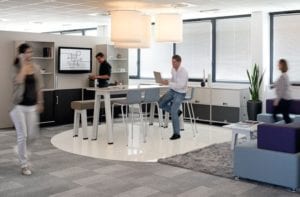With ever-increasing stress and challenges to mental health, ensuring our workplaces are designed to promote optimum conditions is not only important but central to keeping businesses running. Essentially, the biggest capital investment a company makes is its employees. To ignore sick, stressed, sleep-deprived, or disengaged employees is tantamount to ignoring the upkeep of a building.
There are four key areas to consider when designing to optimise mental health in workplaces.
Light and colour
Science tells us that there is a significant effect of air quality and light exposure on circadian rhythms, social behaviours, mood, physical well-being and sleep quality. Working in poor or insufficient lighting can lead to headaches, eye strain and tiredness, ultimately causing stress, anxiety and depression.
The colours we surround ourselves with also affect how we feel. Light is made of colour, it converts into electrical impulses when it hits our retina. These impluses pass into the hypothalamus and affect the release of hormones. Green, particularly, is a mood-enhancing colour and is known to reduce stress.
Using plants, green-view windows, water features and other biophilia can help mitigate stress triggers for employees, creating a healthier and more soothing workplace for your staff. Perhaps if you have a balcony or roof-top space, consider fitting it out as a lunch space or workspace and encourage its use.
Organisation
Working in a soothing and harmonious environment helps to lower stress hormone levels, blood pressure, anxiety levels and depression. Ensuring that your space is organised, arranged and functional for employees is part of making a space optimal for mental health.
There is a need to strike a balance between simplicity and minimalism, and the colourful, casual Google-esque office. What feels right will depend on your company, culture, employees, business and a host of other factors. Aim for engaging, fit-for-purpose and soothing versus cluttered and distracting.
Social Relations
A company where employees experience good communications and strong social support are perceived as being healthier, have higher job satisfaction, morale, lower absenteeism and a desire to leave. However, balancing the need for an individual to have space for themselves, a sense of community and togetherness and strong social support is key. People have varying needs to be alone, to be known and to know others.
Ensuring that there are a good mixture of collaborative, social, private and quiet spaces will give employees options. It empowers them to get their work done in the way they like.
Health
 Office designs have previously focused on time efficiency, putting everything at easy reach. In todays thinking, the desire to enable incidental movement for employees is important in helping them with their health goals.
Office designs have previously focused on time efficiency, putting everything at easy reach. In todays thinking, the desire to enable incidental movement for employees is important in helping them with their health goals.
Encourage staff to take the stairs, discourage eating at desks (by providing an alternative) and offer sit-stand desks. Provide mobile phones to allow people to move around rather than being tied to a desk and place amenities on the periphery so that people need to walk a bit further to access them.
What to consider
- Dont make health and wellbeing a fad in your office or a bandaid to a problem. Options like sleep pods while helpful for mindfulness or a power nap, shouldnt be used to replace healthy sleep patterns. If your employees are working too long or sleeping in the office, a different conversation is required.
- Workforces are aging and there will be some who are less fit, well and able. Remember to include options for those who need it.
Fundamentally investing in the health and wellbeing of employees is good business. Staff treated well, with respect are more likely to be retained, be more innovative, and be happier and more productive at work. That in itself is worth making the change.